I’m not sure if this shrike was learning the impaling process or practicing it. If it was for practice he needed it.
A week ago I posted photos of a Loggerhead Shrike pulling a chunk of flesh off of an impaled vole, which reminded me of a post I published back in 2012 of another shrike attempting to impale a grasshopper on a barbed wire fence. Very few current blog followers have seen that post so I decided to publish it again. For this version I’ve rewritten much of the text, tweaked the formatting and changed the title.
Loggerhead Shrikes, sometimes called “butcher birds” for good reason, often impale their prey on sharp projections to store it in their “larder” and/or give them the leverage they need to pull chunks of the prey off just prior to swallowing. In the summer of 2012, on a visit to the family farm in northwest Montana, I found a Loggerhead Shrike with a grasshopper in ‘his’ bill on a barbed wire fence right in front of the farmhouse I grew up in. Or at least where it used to be.
The following photos document his attempt to impale the grasshopper on one of the barbs of the barbed wire. The shrike was strongly side lit, the light was harsh and I seldom got a catch light in his eye but the photos document the behavior well. Some of the photos are a little dark but I didn’t have time to reprocess them.
Impaling behavior is apparently innate in shrikes but it still takes practice, lots of practice, in order to do it well.
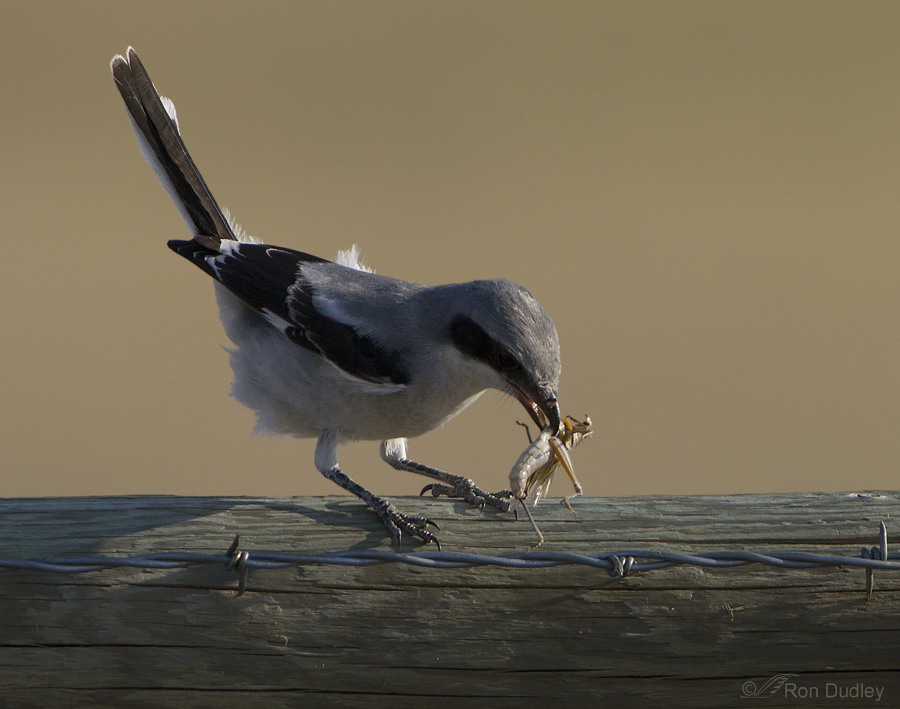
Immediately after approaching the shrike it became obvious that he was going to attempt to impale the grasshopper on the barb just below and in front of his face.
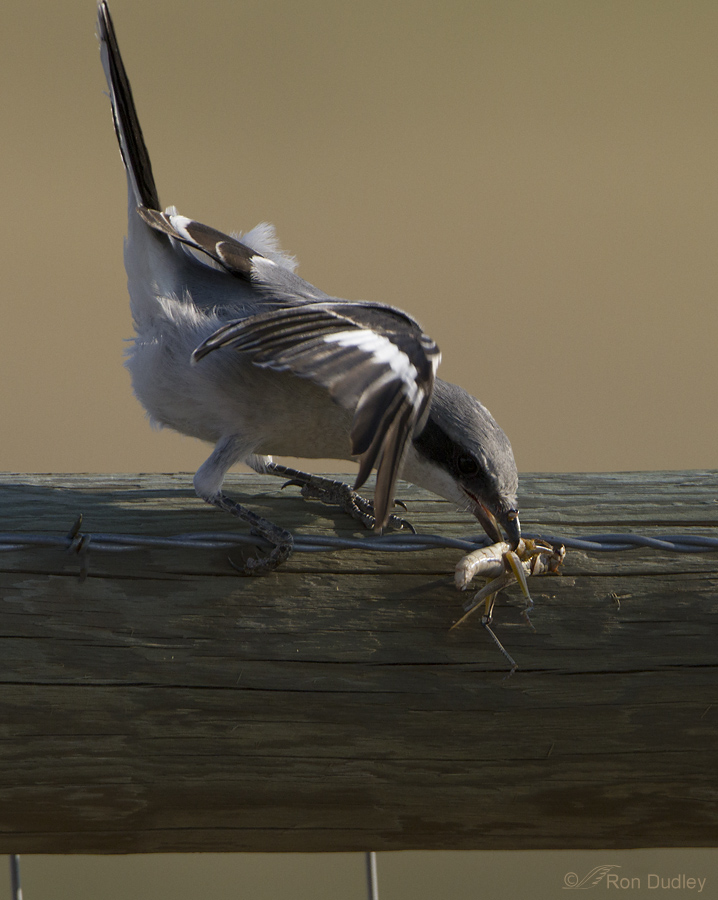
But the barb was at an awkward angle where the rounded fence rail dropped off steeply so he had a devil of a time getting it done.
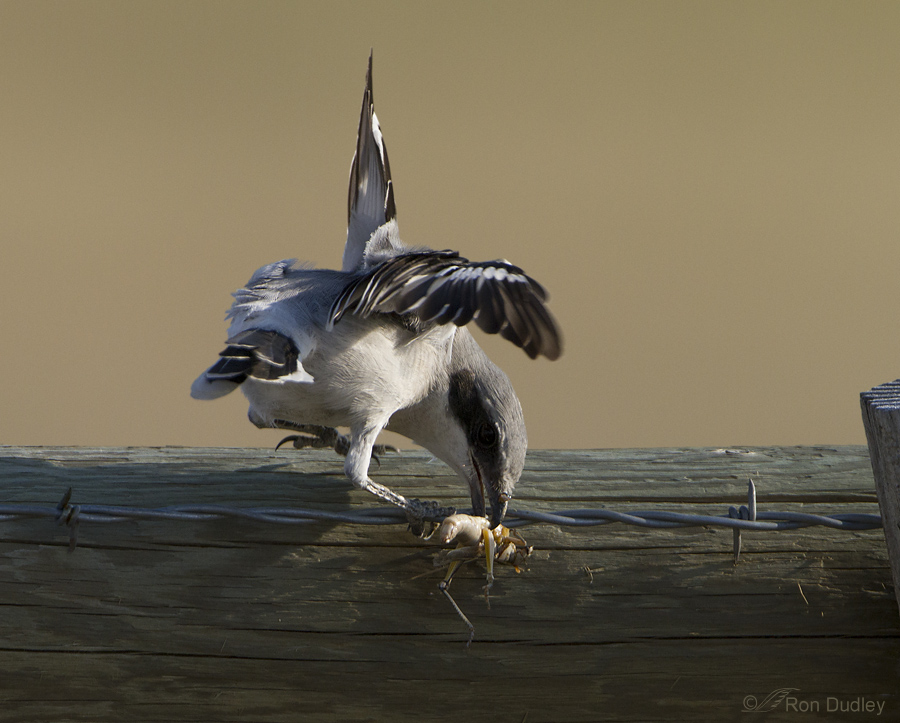
Because he had to get the grasshopper impaled and keep from falling off the fence rail at the same time the body contortions required were…
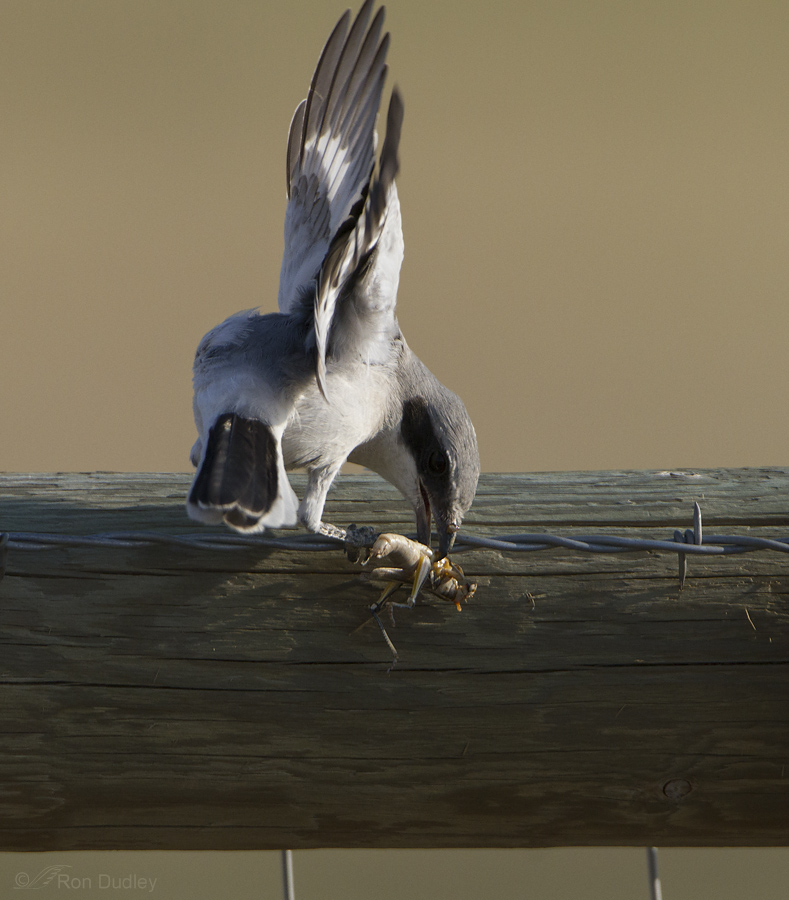
perhaps the most unusual I’ve ever photographed in a bird.
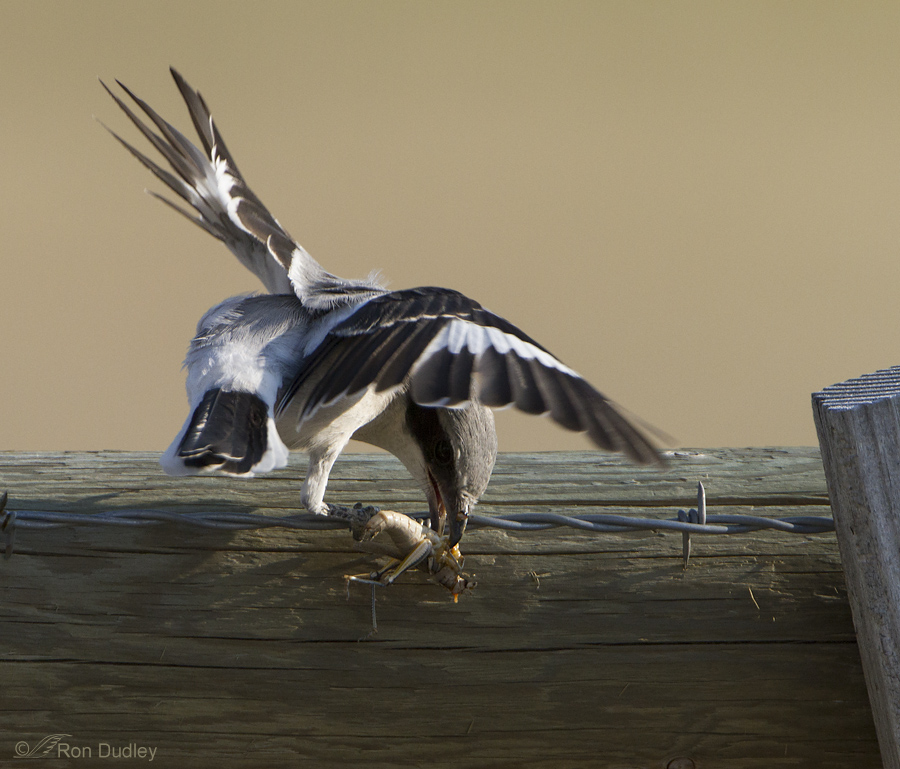
Applying enough force on the grasshopper in one direction to get it pulled onto the barb kept pulling the shrike further down the steep slope of the fence rail.
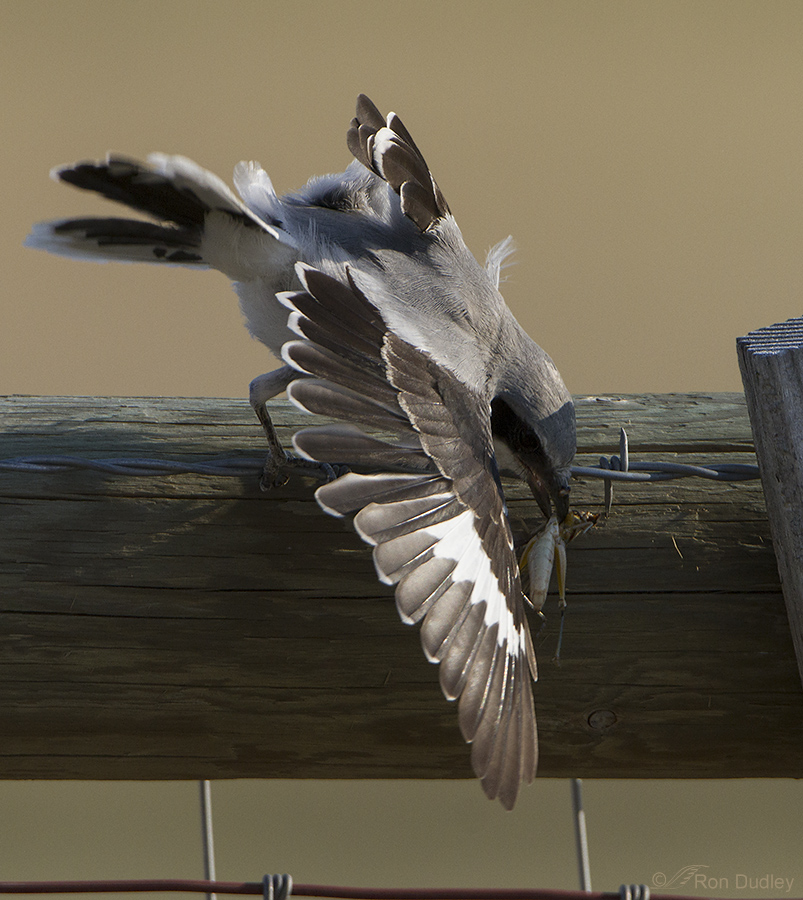
At one point he very nearly fell off the fence. And the grasshopper still wasn’t impaled on the barb..
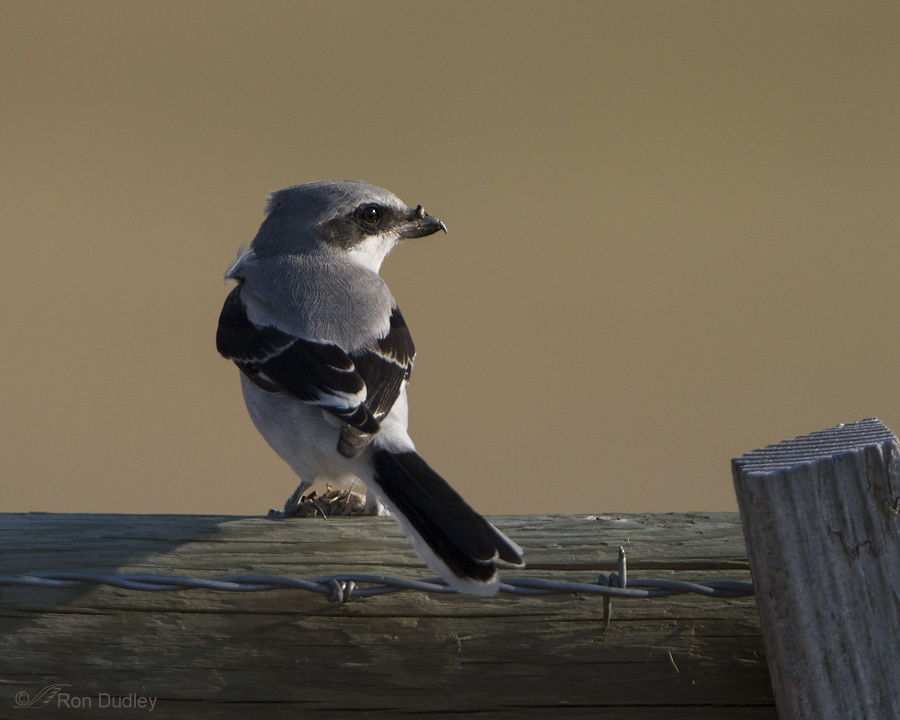
After a while he appeared to give up. He turned his back to me with the grasshopper between his legs and a gob of grasshopper guts on his bill and seemed to contemplate what to do next.
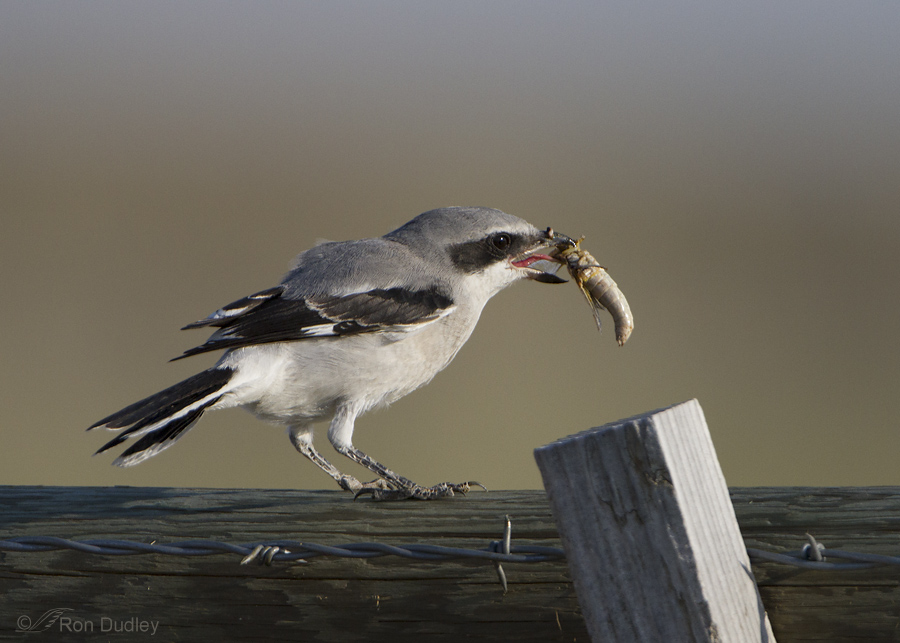
Once his decision was made he just ate the darned thing.
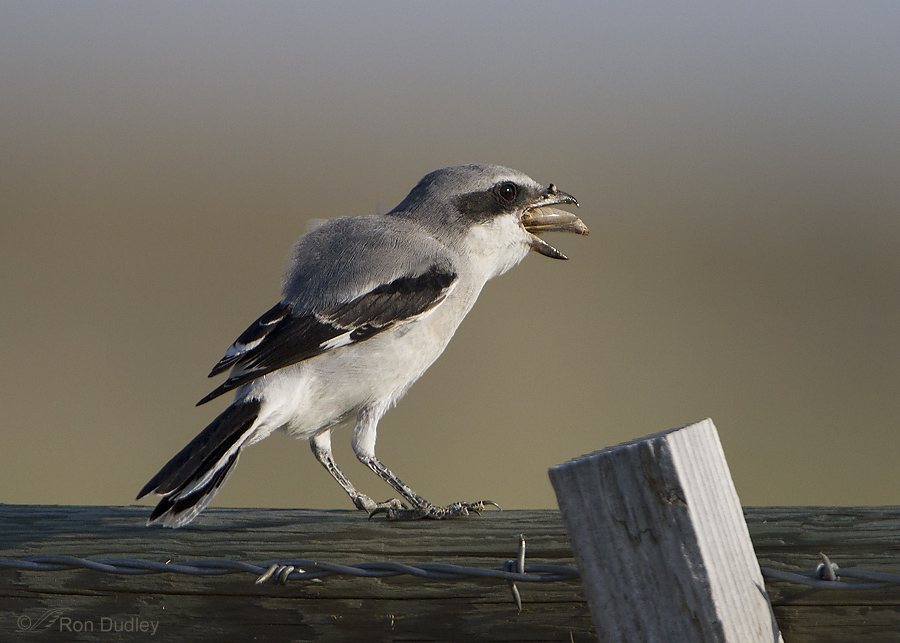
And he did it with gusto.
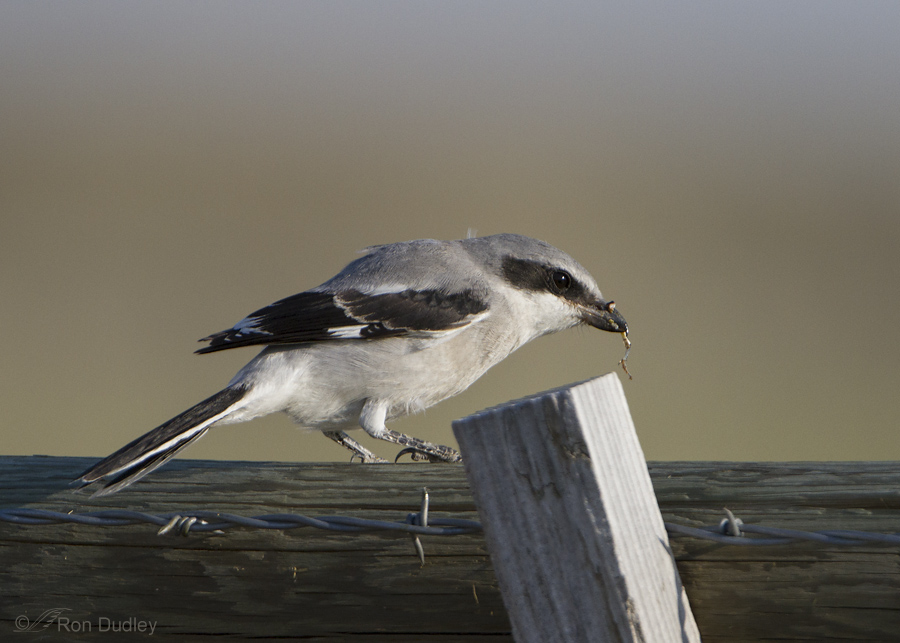
He was rewarded when he found dessert laying on the fence behind the square post – a leftover leg.
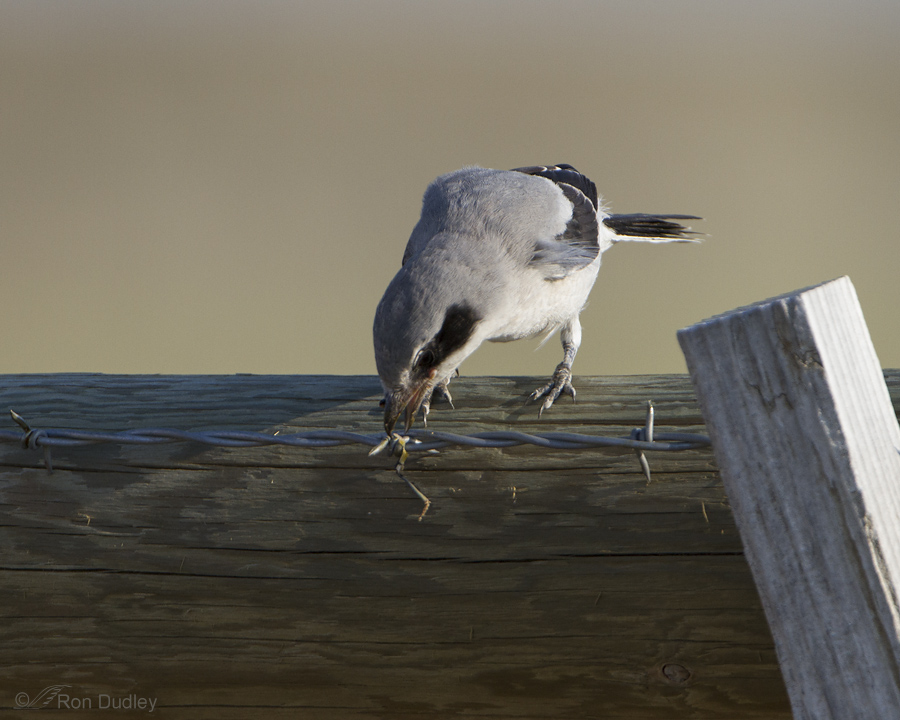
The silly bird tried to impale the leg on the same barb as before but of course it didn’t work. The leg was just too small for the barb. I can’t remember if he swallowed or dropped the leg.
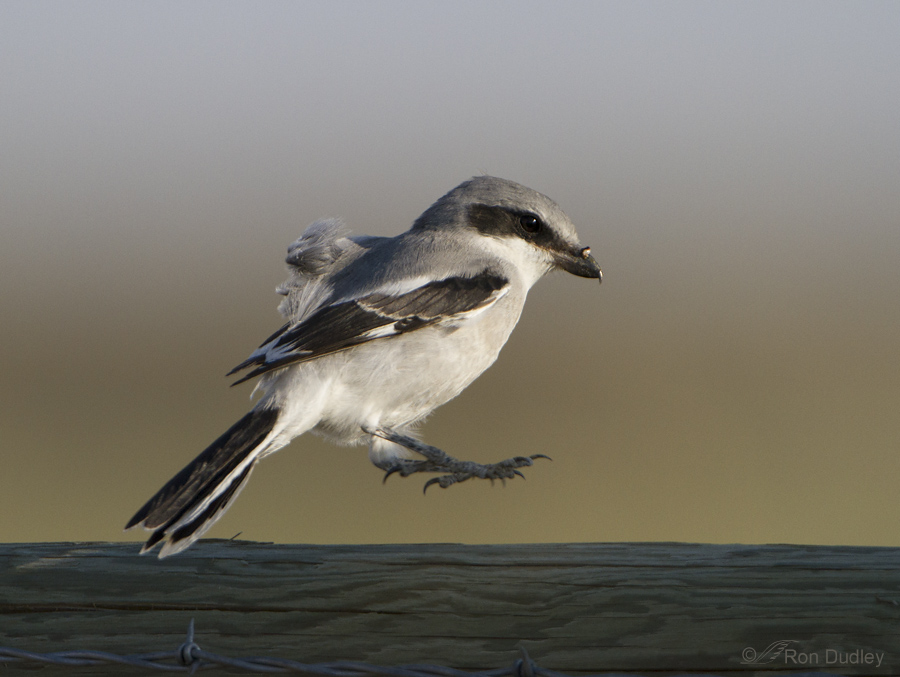
When it was all over he performed one hop and took off, with the grasshopper guts still on his bill..
Impaling prey is a complex behavior and an inexact science so I suspect the learning process goes on for the life of the bird. And that’s a good thing for me because I love photographing the behavior.
Ron


What a delightful series, Ron! I found myself wanting to help him impale that ‘hopper — or at least tell him to move one barb over. I’m glad he at least got his meal.
“I found myself wanting to help him impale that ‘hopper””
That’s exactly how I felt when I was watching him, Marty. He was trying so hard!
Sensational series Ron! Thanks for sharing!
Charlotte Norton
Thanks, Charlotte.
Thank you so much for this series! It was fascinating to see all the bird’s attempts to impale the insect and as you said, all the contortions the bird had to make for his meal. In the end the bird did the right thing–just swallow the damned thing! I learned a lot with this series. Thanks, Ron!
“I learned a lot with this series”
Good. Thank you, Pat.
Ron,
That left-over leg is like the “bonus French (freedom) fry” in the bottom of the sack at McDonals when all the rest are gone! Hilarious series, especially with your commentary.
Stephen
Much appreciated, Stephen. I’ve scrounged the bottom of the bag for the last fry more than once.
Those fries are the best-tasting ones — even if they’re cold!
Wonderful (even comical) series, although serious business for the shrike. Fascinating behavior — and that little hop at the end is delightful! So glad you reposted these.
Thank you, Chris.
Yet another BRILLIANT behavioural series.
This wannabe raptor would undoubtedly have skewered her face. Love and envy those dextrous contortions and the happy hop at the end is perfect.
Thanks, EC. I thought the “happy hop” was a delightful way to end the episode.
Wonderful series of images. The contortion shots are great. I also wonder why he didn’t use a barb that was closer to the top of the rail. Of course, he also tried to impale the leg….Definitely learning his chops.
Yeah, some of what he attempted doesn’t seem very logical to us. On the other hand it’s pretty amazing that a small bird with such a small brain is capable of the behavior in the first place. Perhaps it’s as much trial and error as anything.
These are really fantastic photos documenting this behavior, even if his technique was a little unpolished (or maybe even more so because of that). Thanks for revisiting these.
I’m glad you enjoyed them, Bill. Thanks.
Astounding series of bird behavior! It doesn’t hurt that the images are technically amazing.
Love finding Shrikes. They always seem to engage in fascinating behavior.
I empathize with this poor bird. The other night I had a small salad. One lone cherry tomato remained in the bowl. No matter how I tried, I couldn’t stab it with my fork. Scooping it up simply resulted in it rolling off the fork. Just like your Shrike, frustration set in and I turned up the bowl and tossed the tomato down my gullet. Arising from the dinner table, I did a short hop and flew to the kitchen with my dirty dishes.
Wally, I hope your wife photographed that little episode! If so, please publish the photos on your blog…
Wow! What a powerful series! So much info and interest here. And you have now answered my nature/nurture question so well. As with so many other things it appears that “the answer” is that the behaviour lies somewhere along a continuum. Fascinating. It must have been so exciting to watch.
It certainly was exciting to watch, Granny Pat. And to photograph because I can relive some of the excitement every time I look at the photos.
In addition to the reasons you give for impaling, I would add that it acts as a meat tenderizer. At least that must have been the result in this case. Very entertaining series. Vlad the Impaler her ain’t–yet.
Lyle, here’s another reason for impaling. Freshly killed lubber grasshoppers are poisonous to birds. So shrikes impale them to store them for a couple of days until the poison is degraded and becomes harmless. Then and only then does the shrike eat the lubber grasshopper.
A comic book strip!
Awesome series right down to the joyful little hop at the end!
Thank you, Jamila.
Fantastic series, Ron. And I think the learning process goes on for life for all of us.
Thanks, Cathryn.
I dunno. Some folks don’t appear to have learned anything for years. But I get your point.
Interesting! Amazing the contortions it went through trying to impale the grasshopper. Wonder why it didn’t use the upright barb close by? At least he DID get his meal……
Judy, I took these photos with an older camera with a relatively slow burst rate. If I’d had the burst rate of my newer camera I’m sure I’d have been able to get many more photos of the shrike in weird postures.
Wonderful series, Ron!! I’d never seen it before since I only found your site in 2014!! I have a friend who I I believe I’ve told you about. Phil Rathner, who is a photographer like you as well as a wonderful painter, has been lucky enough to have a pair of Loggerhead Shrikes he’s been able to follow & photograph for 8 or more years, including seeing them raising a “family” every year. Their nest is practically outside his back door!!
Jo Ann, your friend Phil is a lucky man. A very lucky man.
Funnier than Wiley the coyote and the road runner!
Thanks, Terri.